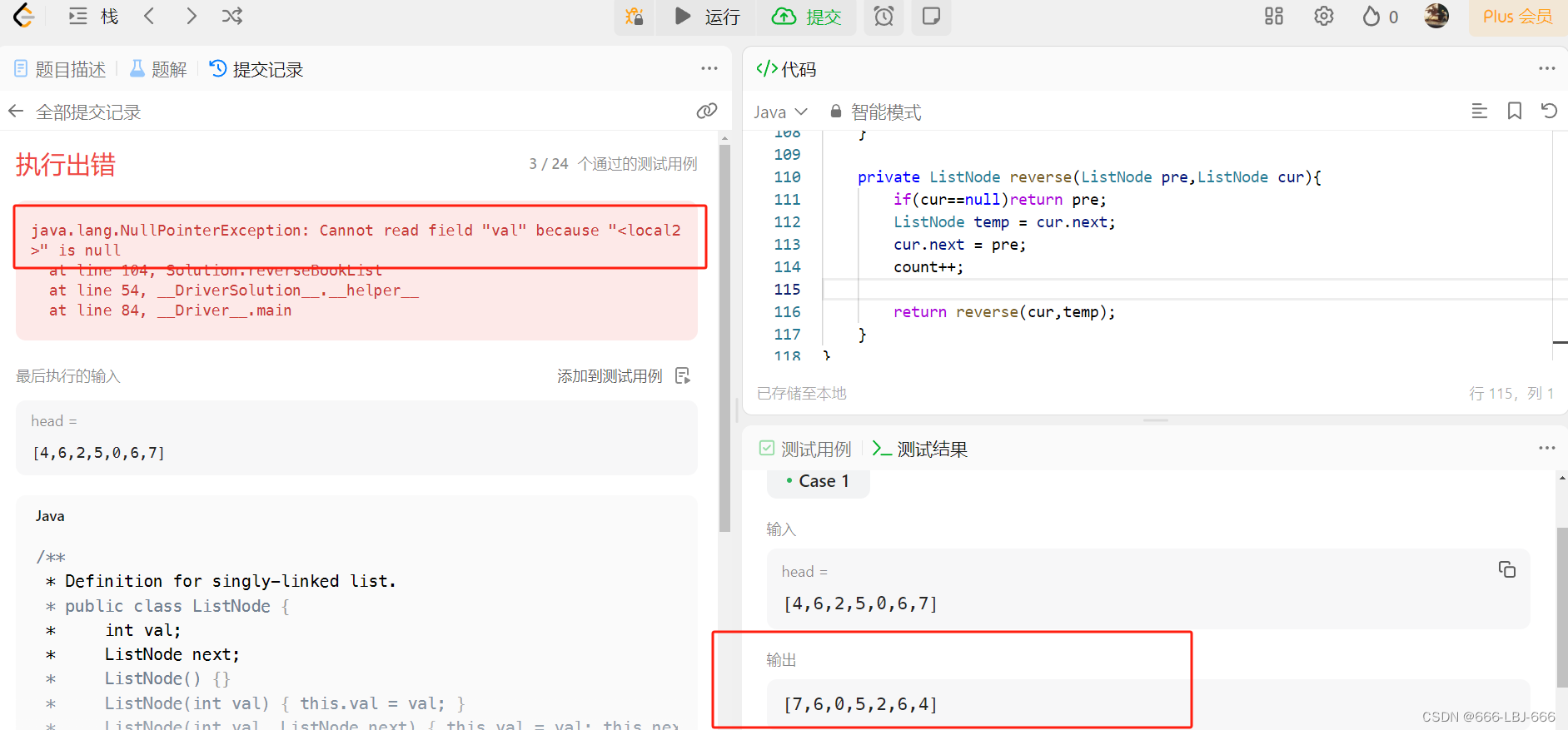每日一练:LeeCode-LCR 123. 图书整理 I (反转链表)(简)【栈、头插法(虚拟头结点)、双指针、递归】
发布时间:2024年01月02日
本文是力扣LeeCode-LCR 123. 图书整理 I (简) 学习与理解过程,本文仅做学习之用,对本题感兴趣的小伙伴可以出门左拐LeeCode。
书店店员有一张链表形式的书单,每个节点代表一本书,节点中的值表示书的编号。为更方便整理书架,店员需要将书单倒过来排列,就可以从最后一本书开始整理,逐一将书放回到书架上。请倒序返回这个书单链表。
示例 1:
输入:head = [3,6,4,1]
输出:[1,4,6,3]
提示:
0 <= 链表长度 <= 10000
很明显这道题的意思就是反转链表,笔者在这总结了4种方法,供大家参考。
这道题可以使用栈、头插法、双指针、递归等方法,推荐使用头插法
头插法(虚拟头结点)
使?虚拟头结点,通过头插法实现链表的反转(不需要栈),建议画图模拟一下
class Solution {
public int[] reverseBookList(ListNode head) {
if(head==null)return new int[]{};
if(head.next==null)return new int[]{head.val};
ListNode dummy = new ListNode(-1); 创建虚头结点
dummy.next = null;
ListNode cur = head;
int count = 0;
// 遍历所有节点
while(cur!=null){
ListNode temp = cur.next; //保存cur的下一节点,迭代使用
// 头插法
cur.next = dummy.next;
dummy.next = cur;
cur = temp;
count++;
}
//满足题意,主要流程为上面
int[] res = new int[count];
for(int i=0;i<count;i++){
res[i] = dummy.next.val;
dummy=dummy.next;
}
return res;
}
}
时间复杂度: O(n)
空间复杂度: O(1)
栈方法
- ?先将所有的结点?栈
- 然后创建?个虚拟虚拟头结点,让cur指向虚拟头结点。然后开始循环出栈,每出来?个元素,就把它加?到以虚拟头结点为头结点的链表当中,最后返回即可
class Solution {
public int[] reverseBookList(ListNode head) {
if(head==null)return new int[]{}; //如果链表为空,返回空数组
if(head.next==null)return new int[]{head.val}; //如果链表中只有?个元素,则直接返回该元素数组
Stack<ListNode> stack = new Stack<>(); 创建栈 每?个结点都?栈
ListNode cur = head;
while(cur!=null){
stack.push(cur);
cur = cur.next;
}
// 创建?个虚拟头结点
ListNode dummy = new ListNode(0);
cur = dummy; //指针传递
int size = stack.size();
while(!stack.isEmpty()){
ListNode node = stack.pop();
cur.next = node;
cur = cur.next;
}
cur.next = null; //最后?个元素的next=null,否则成环了
//满足题意,主要流程为上面
int[] res = new int[size];
for(int i=0;i<size;i++){
res[i] = dummy.next.val;
dummy=dummy.next;
}
return res;
}
}
双指针法
class Solution {
public int[] reverseBookList(ListNode head) {
if(head==null)return new int[]{};
if(head.next==null)return new int[]{head.val};
ListNode cur = head;
ListNode pre = new ListNode(0);
pre = null;
int count = 0;
while(cur!=null){
ListNode temp = cur.next; // 保存?下 cur的下?个节点,因为接下来要改变cur->next
cur.next = pre; // 翻转操作
// 更新pre和cur,准备作下一次循环
pre = cur;
cur = temp;
count++;
}
//满足题意,主要流程为上面
int[] res = new int[count];
for(int i=0;i<count;i++){
res[i] = pre.val;
pre=pre.next;
}
return res;
}
}
时间复杂度: O(n)
空间复杂度: O(1)
递归
这种方法和双指针异曲同工,有了双指针的理解,这种方法,可以直接写出来
class Solution {
private static int count = 0;
public int[] reverseBookList(ListNode head) {
if(head==null)return new int[]{};
if(head.next==null)return new int[]{head.val};
ListNode pre = reverse(null,head);
int[] res = new int[count];
for(int i=0;i<count;i++){
res[i] = pre.val;
pre=pre.next;
}
return res;
}
private ListNode reverse(ListNode pre,ListNode cur){
if(cur==null)return pre;
ListNode temp = cur.next;
cur.next = pre;
count++;
// 递归的写法,其实就是做了双指针法这两步
// pre = cur;
// cur = temp;
return reverse(cur,temp);
}
}
这种方法,笔者还没通过提交,但是单独测试报错的例子,也可以通过,有点百思不得其解,望大佬指出问题。

时间复杂度: O(n), 要递归处理链表的每个节点
空间复杂度: O(n), 递归调?了 n 层栈空间
大家有更好的方法,请不吝赐教。
文章来源:https://blog.csdn.net/kdzandlbj/article/details/135343734
本文来自互联网用户投稿,该文观点仅代表作者本人,不代表本站立场。本站仅提供信息存储空间服务,不拥有所有权,不承担相关法律责任。 如若内容造成侵权/违法违规/事实不符,请联系我的编程经验分享网邮箱:chenni525@qq.com进行投诉反馈,一经查实,立即删除!
本文来自互联网用户投稿,该文观点仅代表作者本人,不代表本站立场。本站仅提供信息存储空间服务,不拥有所有权,不承担相关法律责任。 如若内容造成侵权/违法违规/事实不符,请联系我的编程经验分享网邮箱:chenni525@qq.com进行投诉反馈,一经查实,立即删除!
最新文章
- Python教程
- 深入理解 MySQL 中的 HAVING 关键字和聚合函数
- Qt之QChar编码(1)
- MyBatis入门基础篇
- 用Python脚本实现FFmpeg批量转换
- 干洗店洗鞋店小程序开发系统功能特色
- 阿里云Code的代码仓库忘了升级导致现在找不到了怎么办?
- 连通图、强连通、单侧连通、弱连通
- Java版商城:Spring Cloud+SpringBoot b2b2c实现多商家入驻直播带货及 免 费 小程序商城搭建的完整指南
- kotlin运行
- 回顾2023,那些令 AI 圈大地震的瞬间!
- 数组索引越界异常
- 【数据结构】图论与并查集
- 【算法练习】leetcode算法题合集之数组和哈希表篇
- 宠物自助洗护小程序系统